by C. Elkins, OK Math and Reading Lady
This week I will focus on subtraction problem structures. There are two types: separate and compare. I suggest teaching these models separately. Also, some part-part-whole problems can be solved using subtraction. I will refer to the same terms as in addition: start, change, result. You can also use the same materials used with addition problems: part-part-whole templates, bar models, ten frames, two-color counters, number lines, and connecting cubes.
The goal is for students to see that subtraction has different models (separate vs. comparison) and an inverse relationship with addition — we can compose as well as decompose those numbers. Knowledge of number bonds will support the addition / subtraction relationship. Here is the same freebie I offered last week you can download for your math files: Addition and Subtraction Story Structure Information The six color anchor charts shown below are also attached here free for your use: Subtraction structure anchor charts
Separate: Result Unknown
- Example: 10 – 4 = ____; There were 10 cookies on the plate. Dad ate 4 of them. How many are left on the plate?
- Explanation: The problem starts with 10. It changes when 4 of the cookies are eaten. The result in this problem is the answer to the question (how many are left on the plate).

- Teaching and practice suggestions:
- Ask questions such as: Do we know the start? (Yes, it is 10.) Do we know what changed? (Yes, 4 cookies were eaten so we take those away.) How many cookies are left on the plate now? (Result is 6.)
- Reinforce the number bonds of 10: What goes with 4 to make 10? (6)
- Draw a picture to show the starting amount. Cross out the items to symbolize removal.
- Show the problem in this order also: ____ = 10 – 4. Remember the equal sign means the same as — what is on the left matches the amount on the right of the equal sign.
Separate: Change Unknown
- Example: 10 – ___ = 6: There are 10 cookies on the plate. Dad ate some of them. Now there are 6 left. How many did Dad eat?
- Explanation: The problem starts with 10. It changes when some of the cookies are eaten. The result is that 6 are left on the plate.
- Teaching and practice suggestions:
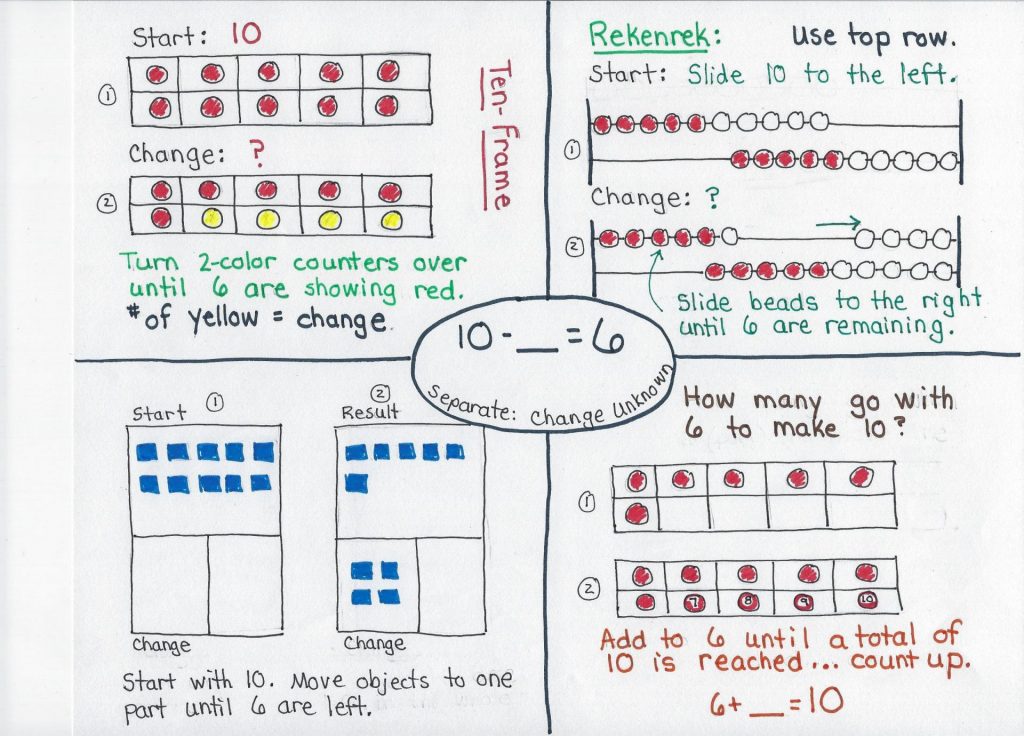
- Ask questions such as: Do we know the starting amount? (Yes, there were 10 cookies on the plate.) Do we know what changed in the story? (Yes, Dad ate some of the cookies, but we don’t know how many.) Do we know the result? (Yes, we know 6 were left on the plate.) So the mystery is, “How many cookies did Dad eat?”
- Show the starting amount (10) and take away items until the result is showing. The answer (change) is the number of items you took away.
- Count up from the lowest amount to the starting amount.
- Reinforce knowledge of number bonds by asking, “What goes with 6 to make 10?”
Separate: Start Unknown
- Example: ___ – 4 = 6: There were some cookies on a plate. Dad ate 4 of them. Now there are 6 left on the plate. How many were on the plate to start with?
- Explanation: The start of this story is unknown. However, we know how it changed (some cookies were eaten). The result is that 6 were left on the plate.
- Teaching and practice suggestions:
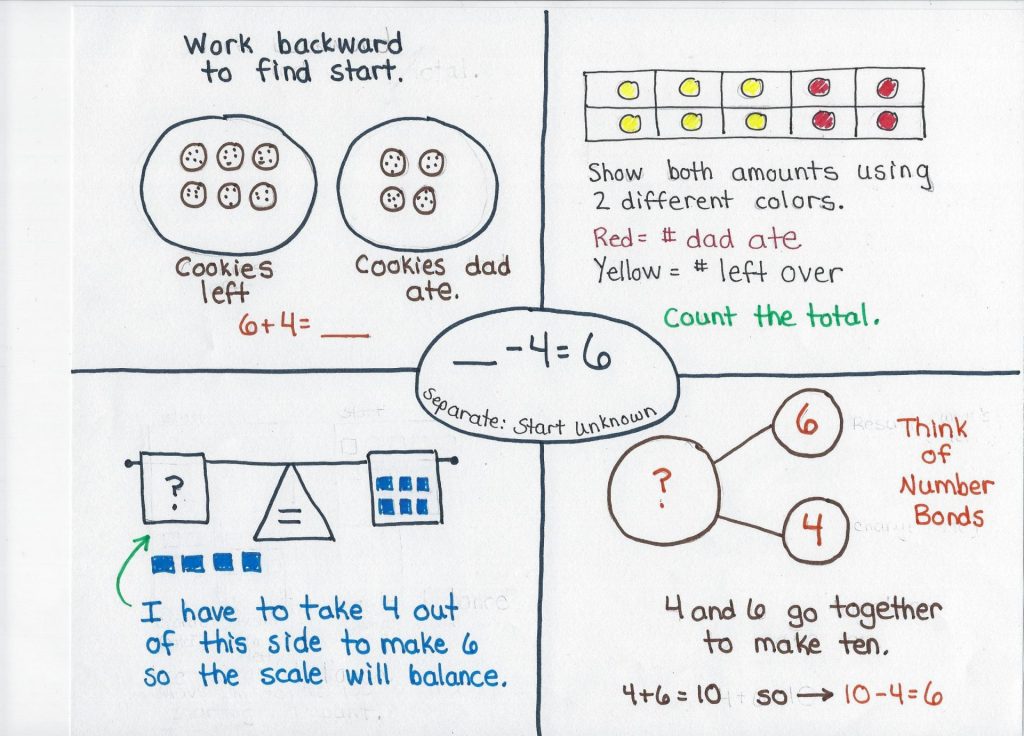
- Ask questions such as: Do we know how many cookies were on the plate to start with? (No.) Do we know what changed in the story? (Yes, Dad ate 4 cookies, meaning they were removed.) Do we know the result? (Yes, 6 cookies were left on the plate.)
- Go in reverse order to reenact the story. Put 6 cookies on the plate. Put back the 4 cookies dad ate to find what there was at the beginning of the story.
- Reinforce knowledge of number bonds: “6 and 4 go together to make ____. “
Brainstorm other words / verbs which show a subtraction action. Keep them posted in the room for future reference. Add to the list as you encounter more words. Here are some to start with: eat, spend, take away, run away, walk away, lose, break, donate, give away, etc.
Comparison Structure
A comparison problem does exactly what it says: Two or more items are analyzed to see how their amounts are the same or different (more or less). There is often no change taking place because nothing is being taken away. Therefore this is a different structure than the above type (separate). You will often encounter these types of problems while using graphs. Watch for problems which often have 2 or more people or two or more objects being compared. Materials to help solve comparison problems are connecting cubes or tiles which can be laid out horizontally above each other to compare. A bar model is helpful to see the difference in the two amounts, especially when using larger numbers. You can also relate knowledge of number bonds to comparison problems.
How many more/ less?
- Example: 12 – 7 = _____ Suzie has 12 bugs in her collection. Josie has 7. How many more bugs does Suzie have than Josie? or How many fewer bugs does Josie have than Suzie?
- Explanation: We are comparing the bugs of two different girls. One has more. The other has less.
- Teaching and practice suggestions:
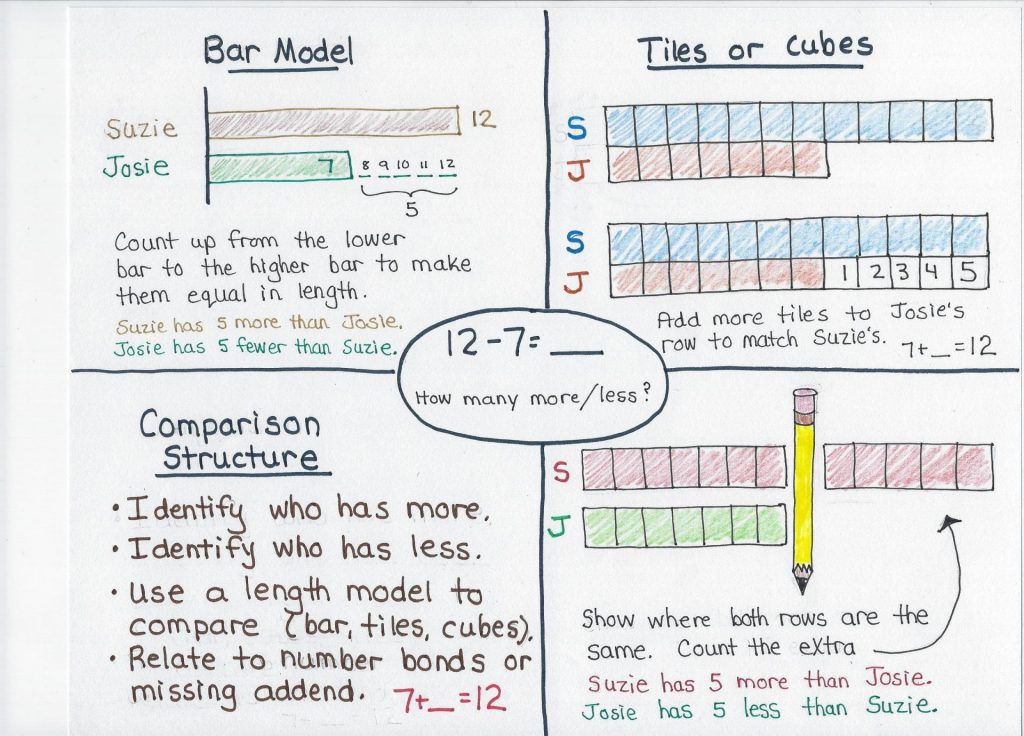
- Identify who has more and who has less. Using a bar model, draw two horizontal bars: One longer for Suzie and one shorter for Josie. Count up from the lower amount to the higher amount to see how much it would take to make them equal. (Or subtract the 2 amounts.)
- Use connecting cubes or color tiles. Lay out two horizontal rows to match the amounts in the story. Add more cubes to Josie’s row to match Suzie’s row (5). The additive process is often easier than the subtractive process.
- Lay out two horizontal rows of cubes / tiles to match the amounts in the story. With a pencil, show the point where both rows are the same. Then count the cubes that “hang out.” (5).
- As above, lay out two horizontal rows to match the amounts in the story. Take away the cubes from Suzie’s row until it is the same length as Josie’s row (5).
How many?
- Example #1: 12 – 5 = ____: Suzie has 12 bugs in her collection. She has 5 more than Josie. How many bugs does Josie have?
- Explanation: Two girls have bugs. We know Suzie has 12, but don’t know how many Josie has. We do know Suzie has more bugs than Josie.
- Teaching and practice suggestions:
- Use a bar model to show what is known: Suzie’s 12 bugs. Show another bar below it that is shorter. This will be Josie’s bar. Because we were told Suzie has 5 more, we can show this by separating Suzie’s bar into two parts. Then compute 12-5 or 5 + ___ = 12.
- Use cubes or tiles. Lay out 12 in a horizontal row for Suzie. Since she has 5 more than Josie, count off the last 5. Make another horizontal row for Josie to match what is left.
- Example #2: 48 – 15 = ____: The bakery sold 48 cupcakes on Monday. This is 15 more than they sold on Tuesday. How many cupcakes were sold on Tuesday?
- Teaching and practice suggestions:
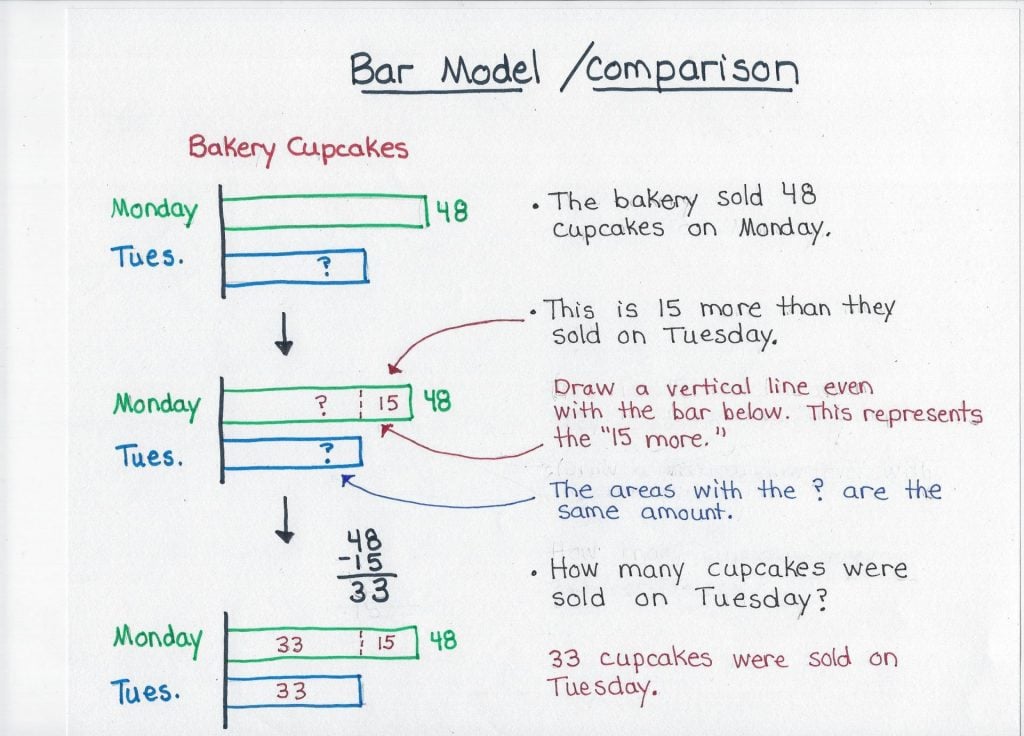
- Use a bar model to show what is known: 48 cupcakes on Monday. Show another bar below it to represent Tuesday’s total, which should be shorter than Monday’s bar. Compute what goes with 15 to equal 48 by counting up or subtracting.
Part-Part Whole Structure
The content of these stories show a part-part-whole relationship usually featuring the same object, but different colors, sizes, types, etc. Part are one color, part are another color. Part are girls, part are boys. Part are striped, part are spotted. There is no real start or change process going on in the story. Knowledge of number bonds is still a key factor in readily knowing the answers. Common words indicating the story follows this structure will be the use of these words: part, some, the rest.
- Here are some examples:
- 10 – 4 = ____; There are 10 puppies at the pet store. 4 are female, the rest are male. How many are male?
- 10 – ___ = 6; There are 10 puppies at the pet store. Some are female, and 6 are male. How many are female?
- ___ – 4 = 6; There are some puppies at the pet store. 4 of them are female. 6 of them are male. How many are there all together?
- Explanation: Identify whether you know the parts and/or the whole.
- Teaching and practice strategies:
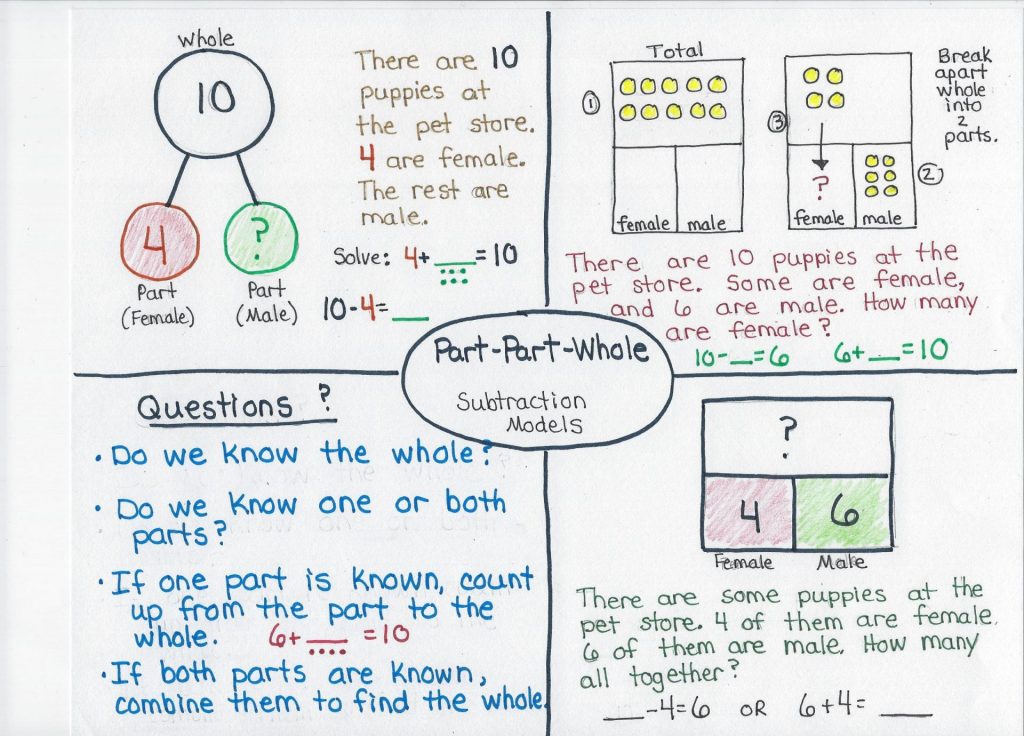
- Ask questions such as: Do we know the whole amount? Do we know one or both parts?
- Use a part-part-whole template to lay out manipulatives.
- Complete the last two examples in the same way you would do a missing addend or change/start unknown problem (see previous post: Part 4).
- If the whole and one part is known, count up from the known part to the whole.
- If both parts are known, but not the whole, combine them to find the whole amount.
- Relate to knowledge of number bonds. What goes with 4 or 6 to make 10?
Key Words: Again, a caution about using key words in the questions as a rule about how to solve the problem. In the “How Many More/Less” scenario teachers typically say to subtract when given this question, but what if a student counts up or is associating a known number bond (what goes with 7 to make 12)? Aren’t they thinking of a way to solve the problem that doesn’t necessarily involve subtraction? And look at the first problem in the “How Many” section. The question asks how many bugs Josie has. If a student adds the numbers in the story (because it asks “how many does she have?”), the student might answer 17, which would not be correct. I could have a story such as: Bill has 5 boxes with his toy cars. Each box has 4 cars. How many cars does Bill have in all? If we give the rule to “Add when the story asks how many in all” then a child might be confused with this story and add 5 + 4 when he actually needs to multiply. Sometimes when the key question words are over emphasized, the students go right to the question, look at the numbers and perform the operation they were told to do without thinking conceptually about the story. I have witnessed this . . . so this is my caution to you to please not use key words as a teaching strategy.
Thanks for checking out this post!!
Extremely educational. Wow. I didn’t know of all these different strategies. Man you make Mathematics understandable .
Thank you so much, Sarah! Glad to have you aboard.
Thank you so much. This information has been helpful. It is easy to follow.